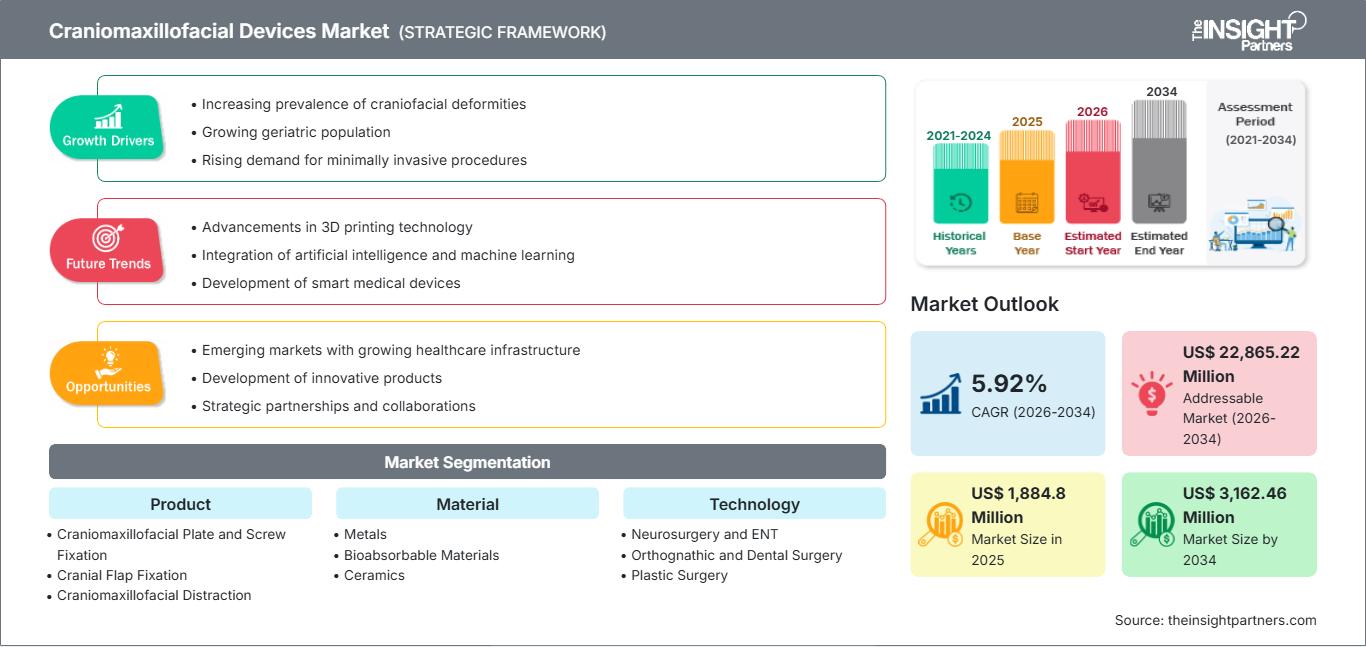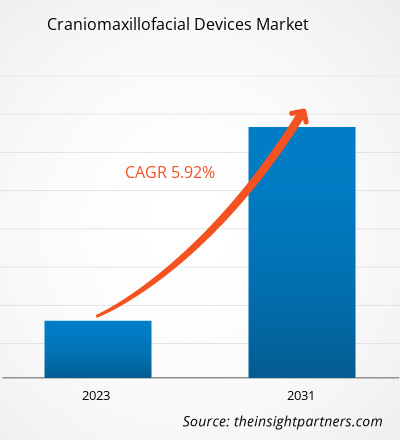Der Markt für kraniomaxillofaziale Implantate, der 2025 einen Wert von 1.884,8 Millionen US-Dollar erreichte, wird bis 2034 voraussichtlich auf 3.162,46 Millionen US-Dollar anwachsen, was einem durchschnittlichen jährlichen Wachstum von 5,92 % im Zeitraum 2026–2034 entspricht. Die Marktbedingungen entwickeln sich stetig weiter und eröffnen den Akteuren neue Chancen. Insgesamt zeichnet sich der Markt durch ein stabiles Wachstum und langfristiges Potenzial aus.
Zu den wichtigsten Wachstumsfaktoren des Marktes für kraniomaxillofaziale Implantate zählen die steigende Nachfrage nach minimalinvasiven Eingriffen, Fortschritte in der 3D-Druck- und Bildgebungstechnologie sowie der weltweite Anstieg schwerer Verletzungen und Gesichtsfrakturen. Dank dieser Fortschritte können Hersteller ihren Kunden maßgeschneiderte Lösungen anbieten. Neben technologischen Innovationen und individuellen Lösungen tragen auch bessere Behandlungsergebnisse maßgeblich zum Wachstum des Marktes für kraniomaxillofaziale Implantate bei. Zu den Trends auf diesem Markt gehören Implantate aus bioresorbierbaren Materialien, die Langzeitprobleme minimieren sollen.
Wachstumstreiber und Herausforderungen:
Der Bedarf an effizienten rekonstruktiven chirurgischen Eingriffen und die durch Urbanisierung und Industrialisierung bedingte Zunahme von Verkehrsunfällen werden voraussichtlich den Markt für kraniomaxillofaziale Implantate ankurbeln. So zählen beispielsweise Überfälle, Sportverletzungen und Autounfälle zu den vielfältigen Ursachen von Unterkieferfrakturen, wie in dem 2022 veröffentlichten Artikel „Prävalenz und Muster von Unterkieferfrakturen: Eine retrospektive Studie in Indien“ beschrieben wird. Minimalinvasive Techniken haben die kraniomaxillofaziale Chirurgie revolutioniert und bieten Patienten Vorteile wie geringere Narbenbildung, kürzere Genesungszeiten und ein niedrigeres Komplikationsrisiko im Vergleich zu traditionellen offenen Operationen. Die zunehmende Anwendung minimalinvasiver Verfahren steigert die Nachfrage nach spezialisierten, für diese Verfahren entwickelten Implantaten. Kraniomaxillofaziale Implantate wie Distraktoren, Platten, Schrauben und Implantate werden kontinuierlich weiterentwickelt, um den besonderen Anforderungen minimalinvasiver Eingriffe gerecht zu werden und Chirurgen die präzise und effiziente Durchführung komplexer Operationen zu ermöglichen. Darüber hinaus ermöglicht der Fortschritt in der 3D-Drucktechnologie die Verfügbarkeit einer großen Anzahl hochpräziser, patientenspezifischer Implantate. Da immer mehr Gesundheitsdienstleister die Vorteile minimalinvasiver Eingriffe hinsichtlich verbesserter Behandlungsergebnisse und höherer Patientenzufriedenheit erkennen, dürfte die Nachfrage nach innovativen, speziell für diese Techniken entwickelten kraniomaxillofazialen Implantaten in den kommenden Jahren weiter steigen.
Der Mangel an qualifizierten Fachkräften mit fundierten Kenntnissen in fortgeschrittenen Operationstechniken hemmt das Marktwachstum, da Gesundheitsdienstleister Schwierigkeiten haben, die steigende Nachfrage nach komplexen Eingriffen zu decken. Um das volle Potenzial des Marktes für kraniomaxillofaziale Implantate auszuschöpfen und die Behandlungsergebnisse für Patienten zu verbessern, dürfte es entscheidend sein, diese Angebotslücke durch Schulungsprogramme und Bildungsinitiativen zu schließen.
Passen Sie diesen Bericht Ihren Anforderungen an.
Sie erhalten eine kostenlose Anpassung aller Berichte – einschließlich Teilen dieses Berichts, Länderanalysen und Excel-Datenpaketen – sowie attraktive Angebote und Rabatte für Start-ups und Universitäten.
Markt für kraniomaxillofaziale Geräte: Strategische Einblicke

-
Ermitteln Sie die wichtigsten Markttrends dieses Berichts.Diese KOSTENLOSE Probe beinhaltet eine Datenanalyse, die von Markttrends bis hin zu Schätzungen und Prognosen reicht.
Berichtssegmentierung und -umfang:
Die Marktanalyse für kraniomaxillofaziale Implantate wurde unter Berücksichtigung der folgenden Segmente durchgeführt: Produkt, Material und Anwendung. Geografisch ist der Markt in Nordamerika (USA, Kanada und Mexiko), Europa (Großbritannien, Deutschland, Frankreich, Italien, Spanien und übriges Europa), Asien-Pazifik (China, Japan, Indien, Australien, Südkorea und übriges Asien-Pazifik), Naher Osten und Afrika (VAE, Saudi-Arabien, Südafrika und übriger Naher Osten und Afrika) sowie Süd- und Mittelamerika (Brasilien, Argentinien und übriges Süd- und Mittelamerika) unterteilt.
Segmentanalyse:
Produktbasierte Erkenntnisse
Basierend auf den Produkten ist der Markt in folgende Segmente unterteilt: kraniomaxillofaziale Platten- und Schraubenfixation, kraniale Lappenfixation, kraniomaxillofaziale Distraktion, Kiefergelenkersatz, thorakale Fixation und Knochentransplantatersatz. Das Segment der kraniomaxillofazialen Platten- und Schraubenfixation hielt 2023 den größten Marktanteil bei kraniomaxillofazialen Implantaten. Es wird erwartet, dass es von 2023 bis 2031 die höchste durchschnittliche jährliche Wachstumsrate (CAGR) verzeichnen wird.
Materialbasierte Erkenntnisse
Basierend auf dem Material ist der Markt für kraniomaxillofaziale Implantate in Metalle, bioresorbierbare Materialien und Keramik unterteilt. Es wird erwartet, dass das Metallsegment bis 2031 einen bedeutenden Marktanteil halten wird.
Anwendungsbasierte Erkenntnisse
Basierend auf den Anwendungsgebieten ist der Markt in Neurochirurgie und HNO, Kieferorthopädie und Zahnchirurgie sowie Plastische Chirurgie unterteilt. Es wird erwartet, dass das Segment Kieferorthopädie und Zahnchirurgie bis 2031 einen bedeutenden Marktanteil halten wird.
Kraniomaxillofaziale Geräte
Markt für kraniomaxillofaziale Geräte – Regionale Einblicke
Die regionalen Trends und Einflussfaktoren auf den Markt für kraniomaxillofaziale Implantate im gesamten Prognosezeitraum wurden von den Analysten von The Insight Partners eingehend erläutert. Dieser Abschnitt behandelt außerdem die Marktsegmente und die geografische Verteilung des Marktes für kraniomaxillofaziale Implantate in Nordamerika, Europa, Asien-Pazifik, dem Nahen Osten und Afrika sowie Süd- und Mittelamerika.
Umfang des Marktberichts zu kraniomaxillofazialen Geräten
| Berichtattribute | Details |
|---|---|
| Marktgröße im Jahr 2025 | 1.884,8 Millionen US-Dollar |
| Marktgröße bis 2034 | 3.162,46 Millionen US-Dollar |
| Globale durchschnittliche jährliche Wachstumsrate (2026 - 2034) | 5,92 % |
| Historische Daten | 2021-2024 |
| Prognosezeitraum | 2026–2034 |
| Abgedeckte Segmente |
Nebenprodukt
|
| Abgedeckte Regionen und Länder |
Nordamerika
|
| Marktführer und wichtige Unternehmensprofile |
|
Marktdichte der Akteure im Bereich kraniomaxillofazialer Geräte: Auswirkungen auf die Geschäftsdynamik verstehen
Der Markt für kraniomaxillofaziale Implantate wächst rasant, angetrieben durch die steigende Nachfrage der Endverbraucher. Gründe hierfür sind unter anderem sich wandelnde Verbraucherpräferenzen, technologische Fortschritte und ein wachsendes Bewusstsein für die Vorteile der Produkte. Mit steigender Nachfrage erweitern Unternehmen ihr Angebot, entwickeln innovative Lösungen, um den Bedürfnissen der Verbraucher gerecht zu werden, und nutzen neue Trends, was das Marktwachstum zusätzlich beflügelt.

- Verschaffen Sie sich einen Überblick über die wichtigsten Akteure auf dem Markt für kraniomaxillofaziale Geräte.
Regionalanalyse:
Der geografische Geltungsbereich des Marktberichts für kraniomaxillofaziale Implantate umfasst Nordamerika, Europa, den asiatisch-pazifischen Raum, den Nahen Osten und Afrika sowie Süd- und Mittelamerika. Nordamerika hielt 2023 den größten Marktanteil und wird diese Position voraussichtlich auch im Prognosezeitraum behaupten. Die USA sind der größte Marktteilnehmer in Nordamerika und weltweit. Das Marktwachstum in den USA ist auf die hohe Sportbeteiligung, die steigende Anzahl von Gesichtsfrakturen und die große Anzahl internationaler Athleten mit Wohnsitz in den USA zurückzuführen. Darüber hinaus dürfte die wachsende Nachfrage nach minimalinvasiven Eingriffen den Markt in den USA weiter ankurbeln.
Aufgrund seines hochentwickelten Gesundheitssystems hat die USA die Aufmerksamkeit großer globaler Konzerne auf sich gezogen, die ihren Marktanteil ausbauen möchten. Zudem steigt die Zahl der in den USA durchgeführten Operationen jährlich, was dem untersuchten Markt zugutekommt. Die American Academy of Craniomaxillofacial Surgeons erörtert die neuesten Entwicklungen und Besonderheiten der Forschung in der kraniomaxillofazialen Chirurgie. Die Zukunft der fetalen intrauterinen Neurochirurgie und anderer chirurgischer Methoden wurde auf der Jahrestagung 2021 beleuchtet.
Wettbewerbsumfeld und Schlüsselunternehmen:
Die in diesem Bericht präsentierte Marktprognose für kraniomaxillofaziale Implantate unterstützt die Akteure dieses Marktes bei der Planung ihrer Wachstumsstrategien. DePuy Synthes (J&J), Stryker, Medtronic, B. Braun Melsungen AG, Reni Shaw plc., Medartis AG, KLS Martin Group, Xilloc Medical B.V., Synimed und Zimmer Biomet zählen zu den wichtigsten Unternehmen, die im Bericht über den Markt für kraniomaxillofaziale Implantate vorgestellt werden. Diese Unternehmen konzentrieren sich darauf, ihr Angebot zu erweitern, um der weltweit steigenden Kundennachfrage gerecht zu werden. Ihre globale Präsenz ermöglicht es ihnen, zahlreiche Kunden zu bedienen und somit ihre Marktpräsenz auszubauen.
- Historische Analyse (2 Jahre), Basisjahr, Prognose (7 Jahre) mit CAGR
- PEST- und SWOT-Analyse
- Marktgröße Wert/Volumen – Global, Regional, Land
- Branchen- und Wettbewerbslandschaft
- Excel-Datensatz
Aktuelle Berichte
Verwandte Berichte
Erfahrungsberichte
Grund zum Kauf
- Fundierte Entscheidungsfindung
- Marktdynamik verstehen
- Wettbewerbsanalyse
- Kundeneinblicke
- Marktprognosen
- Risikominimierung
- Strategische Planung
- Investitionsbegründung
- Identifizierung neuer Märkte
- Verbesserung von Marketingstrategien
- Steigerung der Betriebseffizienz
- Anpassung an regulatorische Trends






















 Kostenlose Probe anfordern für - Markt für kraniomaxillofaziale Geräte
Kostenlose Probe anfordern für - Markt für kraniomaxillofaziale Geräte